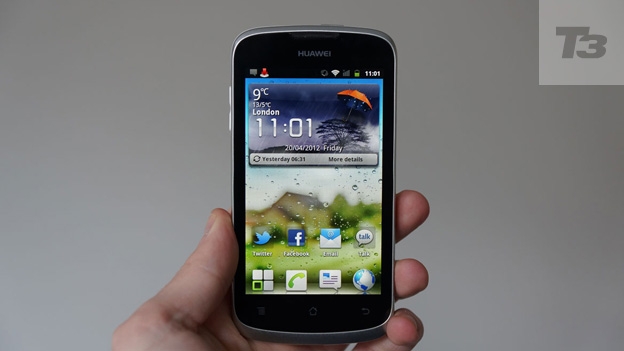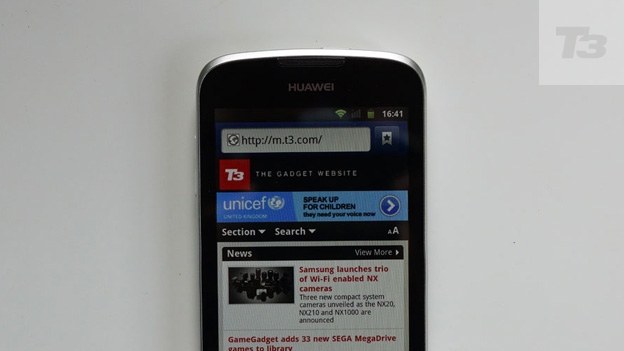Huawei Ascend G300 review
Is the Huawei Ascend G300 a budget Android delight?

-
+
Large
-
+
sharp screen
-
+
Huge battery life
-
+
Decent all-round performance
-
-
Stingy storage
-
-
Unimpressive camera
-
-
Occasional touch sensitivity i
Why you can trust T3








The Huawei Ascend G300 is an ultra-affordable Android 2.3 Gingerbread phone with a 4-inch screen, available for as little as £100 on PAYG
The Huawei Ascend G300 is an incredibly affordable Android handset, available for a mere £100 on a Vodafone PAYG deal. That puts it in line with the likes of the HTC Explorer (£100 on Orange) and LG Optimus L3 (£100 on O2). But does it feel like a cheap choice?
Huawei Ascend G300: Build
The Ascend G300 is surprisingly sturdy for a plastic-bodied smartphone. Sure, it creaks a little when you squeeze it, but its glass front and tough plastic edging feel reassuringly solid. You can prise off the back to get at the SIM, micro SD slot and battery.
Its looks are probably best described as 'functional', but we like the touch-sensitive buttons under the screen. The only physical controls are a power button at the top and a volume rocker on the left side. A micro USB port at the bottom handles charging, and there's a 3.5mm headphone jack at the top.
Huawei Ascend G300: Features
The Ascend G300 rocks a 5-megapixel camera, but it's not one of the best examples of its type: the flash is weak and photos, when viewed at full size, look disappointingly grainy and lacking in detail – even when taken in good light.
Video quality goes up to 800 x 480, and tends to be noisy and blocky. Internal storage tops out at a paltry 2.5GB, but can be increased by up to 32GB by whacking in a micro SD (not supplied).
Huawei Ascend G300: Screen
The screen is a 4-inch 800 x 480 LCD, and in terms of image quality it's impressive: sharp and punchy, with vivid colours. Don't expect iPhone 4S-like levels of crispness or Samsung Galaxy S2-esque colour and contrast, but by budget phone standards this is a peach.
Its touch capabilities (backed up with haptics) aren't so hot, and we'd like it to be a lot more responsive – often it fails to read a tap, which gets to be frustrating.
Huawei Ascend G300: Performance
The G300's single-core 1GHz processor can't match the blistering performance of the latest dual- and quad-core-equipped Android phones (running the AnTuTu Benchmark put it on a par with the original Samsung Galaxy S and the Google Nexus S) but we found it generally delivered a slick experience.
Get all the latest news, reviews, deals and buying guides on gorgeous tech, home and active products from the T3 experts
There's little lag when switching between homescreens or apps, the web browser loads pages rapidly and basic games like Angry Birds Space run perfectly smoothly.
Huawei Ascend G300: Battery
Battery life is one of the G300's strong points: a full charge will last days on standby, and even with normal use you probably won't need to charge it every day (obviously that depends on your definition of 'normal').
Huawei Ascend G300: Verdict
The Huawei Ascend G300 might on paper look like another cheap and less-than-cheerful Android phone, but it's a solid buy considering its price. The screen is top drawer, the battery life is epic and there's enough power on board to perform most tasks more than adequately.
Of course it's not perfect – the camera's poor and the limited storage means you'll need to invest in a micro SD card – but a £100 phone was never going to match up to the iPhone 4S and Samsung Galaxy S IIIs of this world. As it stands, this is a great entry-point into Android.
Huawei Ascend G300 availability: Available now
Huawei Ascend G300 price: £100 on PAYG, £15.50 on a 24-month contract
Sam has been covering tech and culture for more than two decades, first in games journalism and later consumer electronics, streaming entertainment and photography. He has written for the likes of Wired, Stuff, CNET, GQ, Trusted Reviews and CVG, and now lives on the Kent coast – not a bad spot for a camera reviewer to reside.
